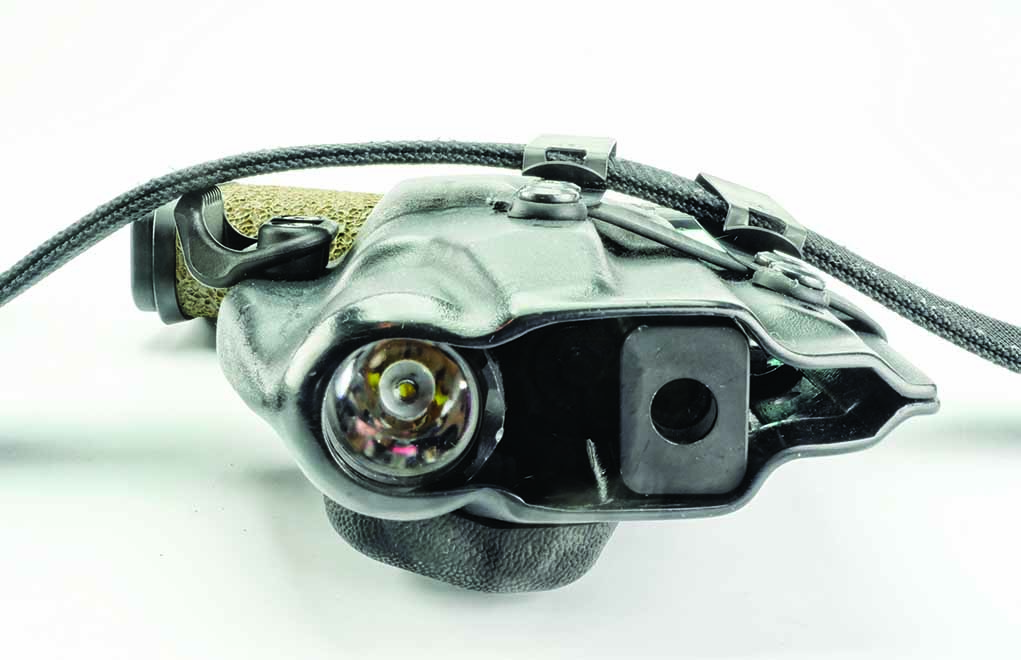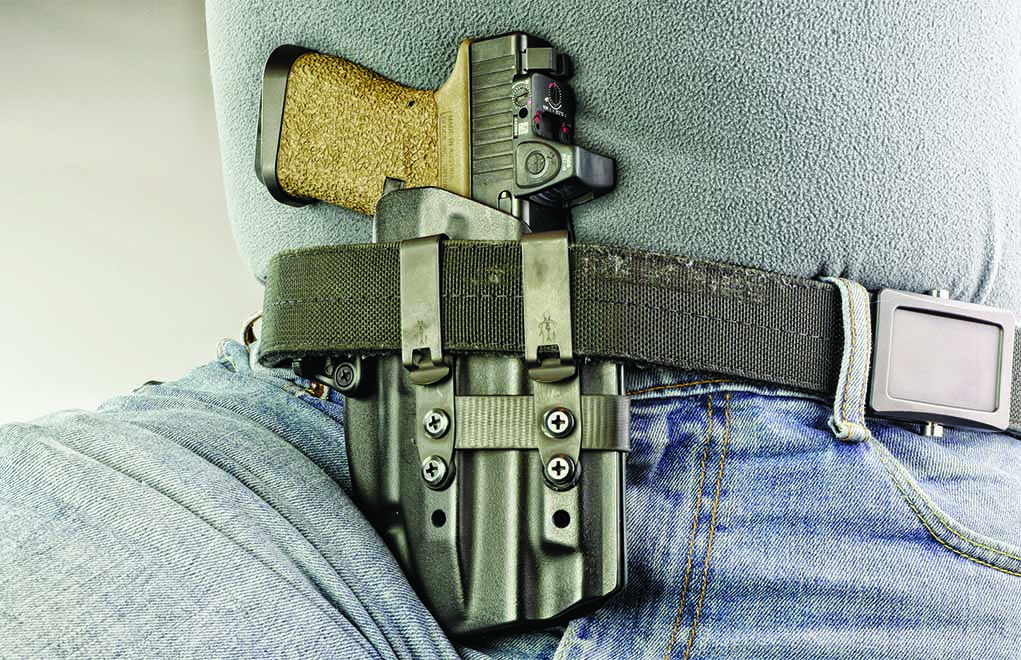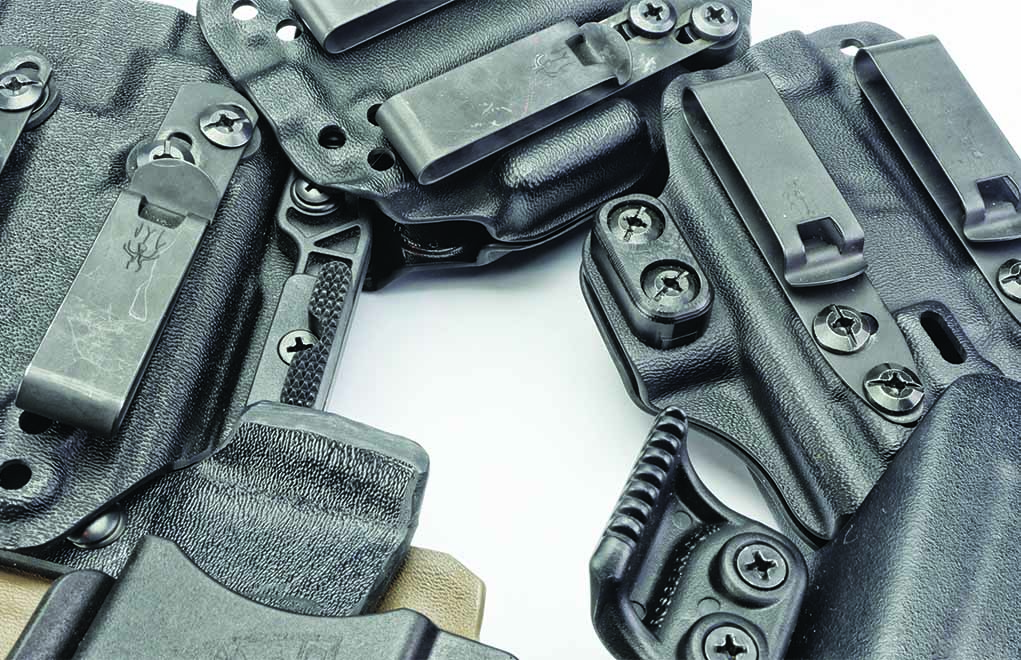

Appendix carry is often maligned. In truth, its comfortable and offers quick access to a gun no matter what position you're in.
What An Appendix Holster Must Have:
- Covers the trigger guard and slide
- Has a built-in wedge or the ability to add one
- Offers a belt attachment option in the “better” or “best” category
- Provides adjustable ride height
- Has a means of rotating the pistol inward
- There are no sharp edges along the bottom of the gun
When the topic of appendix carry comes up, some of the oft-used responses are along the lines of, “Appendix doesn’t work for me”; “AIWB isn’t comfortable for me”; or (my personal favorite): “I don’t want to shoot my @#$% off.”
These complaints are almost always rooted in a poor understanding of how to make appendix carry work, assuming that a shorter pistol slide is better or allowing an opinion to be formed while using a $25 eBay holster that “works for them.”
Once you’ve understood the elements of a good appendix holster and how it should fit onto your body, nearly every concern critics make is almost always addressed with proper equipment selection. If your holster, gun or gun belt isn’t well-suited for appendix, you’re going to have a bad time.
Is appendix carry for everyone? No, but you should be able to follow the tips in this article to have the best chance at success.
Holstering a Loaded Gun Is Dangerous
The most likely time to have a negligent discharge is when holstering your pistol. That isn’t limited to AIWB: Holstering a pistol is universally dangerous if you’re careless. Appendix carry just has higher stakes than other positions. A properly functioning gun in a good holster, along with quality training, will mitigate risk.

“Shooting your @#$% off” should be the least of your concerns if you botch holstering your gun. A far more valuable bit of anatomy than your reproductive organ is also at risk: your femoral artery. Because I don’t like the idea of dying, I came up with some easy-to-remember rules (“N.U.T.S.”) for holstering a loaded gun when carrying appendix:
- Never rush to reholster your firearm.
- Uncover your holster completely.
- Thrust your hips forward.
- Slowly insert your pistol into the holster.
Appendix Carry Benefits
If the whole “if you mess up, you’ll die” thing didn’t put you off, which it shouldn’t, there are some solid payoffs to AIWB. As long as you remember my N.U.T.S. acronym and use quality gear, you probably won’t mess up and die.
Faster and Easier Draw. Some people will note that appendix carry is faster because the gun is closer to where your hands spend most of their time—in front of the body. That isn’t entirely true. Yes, our hands spend most of their time in front of the body, but the draw stroke when placing your gun in the AIWB position is a more natural motion. Your arms want to bend into the centerline of your body; they don’t want to be moved around to your back. Removing the need to reach behind your body’s centerline means you’re no longer at a mechanical disadvantage.
You’re also able to draw your gun in a ton of odd body positions, such as seated (think car, restaurant or place of worship), on your back and pretty much every other position you might find yourself in … as long as you don’t find yourself pinned face-first against something, thereby blocking access to the holster.

You Have More Control. Where carrying on your strong-side hip leaves you at a disadvantage when trying to maintain control of your gun, with appendix, you just push the pistol down into the holster with whatever hand you have free. While it’s a less-ideal method of controlling the pistol, the option to close the gap between you and your attacker and block access to the pistol by sandwiching it between your body and the attacker is another way you can maintain control of your gun.
Concealing Large Guns Is More Comfortable. The most surprising benefit to appendix carry is that when you use a properly set-up holster, appendix carry is generally more comfortable than traditional IWB carry, even when you’re seated. Think of how traditional IWB either places the pistol over your hip bone or presses the slide and muzzle into your gluteal medius (hip muscles) and gluteal maximus (butt cheek) muscles.
When you have a holster that incorporates a way to tilt the gun into your stomach and also rotates the grip toward your body, you’re able to pull off what some might view as impossible—true concealment of large pistols in the same everyday clothing you would wear normally. In fact, there are many who carry (including me) and are able to conceal a Glock 34 or 5-inch 1911-sized pistol on a daily basis without printing.
Appendix Carry Myths
I’m only going to touch on the two most prevalent myths. Addressing every myth about AIWB would not only take a lifetime, but this magazine would deforest a small country!

‘Big’ People Can’t Carry Appendix. “I can’t carry appendix. My gut gets in the way.” Hogwash! There isn’t any magic to being able to conceal a pistol AIWB as a bigger guy, but a larger wedge (we’ll talk about later) is needed to prevent the pistol from tipping out of the pants. Carrying a longer gun—as counterintuitive as it sounds—is also rather helpful in making appendix carry work for bigger guys due to more holster and gun being below the beltline.
You Can’t Draw With One Hand. Again, this is hogwash. Just like traditional IWB, you still need to clear your cover garment. With strong-side carry, this means you rip the cover garment up and use your thumb and palm heel to keep it clear while you acquire your grip and draw. With appendix carry, the process is very similar: Rip the cover garment with your free hand and then stuff it behind the gun and draw.
Choosing An Appendix Holster
Your holster will either make or break your appendix carry experience. While different body types will dictate what best suits you, there are some general features you should look for.
For more information on concealed carry holsters check out:
- Essential Gear: Best Concealed Carry Holsters
- Buckling Up The Basics Of Gun Belts
- Pocket Holster Options For Easy Everyday Carry
- The Shoulder Holster And Its Carry Angle
- Pros And Cons Of The Appendix Carry Holster
Thermoplastics Rule; Leather Drools. The only material I will accept for an appendix holster is Kydex or Bolteron. There are some other derivatives out there, such as Holstex or injection-molded holsters, but anything that can be molded into a ridged shell gets a thumbs-up. Leather isn’t a material that I find acceptable for an appendix holster for one simple reason: Leather degrades over time and becomes soft. Stories of negligent discharges when holstering aren’t hard to find and are almost always linked to a leather or leather-backed hybrid holster past its service life.

A Means to Rotate the Pistol. There are tons of ways to rotate the pistol in toward your body. The purpose is to prevent the butt of the gun from printing and help a flat object follow the contour of your body a bit more closely. These are called “claws,” “camming bars” or “wings.” They all rotate the pistol toward your body.
The concealment wing’s function is simple: to rotate the gun and holster into the torso to prevent printing. It does this by being attached to the holster shell and using pressure from the belt to tuck the gun in neatly. Some good concealment wings to add to a holster include Raven Concealment wings, the ModWing, Dark Star Gear’s Dark Wing or PHLster’s TuckStrut. The Keepers Concealment accomplishes rotation differently; it uses an angle on the forward face of the holster.
Wedges. The purpose of a wedge is to push the muzzle out and the top of the pistol toward your torso for better concealment and comfort. An additional benefit is that depending on your gun selection, the wedge could keep the muzzle clear of anything vital if you mess up while holstering. Most people will benefit from one.
• Built-in Wedges. Tenicor holsters, with their body contour wedge, are the most comfortable integrated wedges I’ve tried. When choosing a holster with a built-in wedge, keep in mind where on your belt line that holster will go. In addition, know that you might need to make some adjustments by adding some foam to the back for more height.
• Semi-Permanent Add-On Wedges. Some holsters (such as my daily-carry Bawidamann Gotham and the Raven Concealment Eidolon) use a rubber wedge that screws onto the back of the holster. A semi-permanent solution that attaches to the holster shell with hardware is an entirely acceptable option if one of the holsters with a built-in wedge doesn’t excite you.
• Add-On Foam Wedges. Other holsters, such as the AIWB holsters from ANR Design, don’t have a good option for a wedge. There are ways around not having a purpose-built wedge—such as using some closed-cell foam, a technique made popular by Spencer Keepers. And some industrial hook-and-loop closures make it a snap to attach a pre-made wedge (for instance, the Keepers Concealment foam wedge or Dark Star Gear’s Flat Pad or Muzzle Pad).
Appendix Holsters to Avoid
No matter what that talking head on YouTube is telling you, a hybrid holster is a terrible option for concealing a pistol in any carry position. What makes holsters such as the Alien Gear line or CrossBreed’s leather-backed holsters so comfortable is that the backer softens over time and conforms to your body. While that’s great for comfort, it’s bad for safety.

When that backer becomes pliable enough, there’s the chance it will fold over while you’re reholstering and make its way into the trigger guard. Sure, you can get one that has a “combat cut,” but I’d recommend just skipping hybrid holster designs altogether.
While there are exceptions to the no-leather “rule,” there just isn’t a good reason to choose leather over a more-modern material such as Kydex. As with the hybrid holster design, leather will soften over time and conform to your gun and body—which, again, is great for comfort. Nevertheless, as was the case with the hybrid holster, that comfort comes at the cost of safety.
Your Belt Matters
Selecting a good gun belt is just as important as selecting a quality holster. That bargain belt you bought at a Sears store liquidation sale or the trendy gun belt you found on Amazon for $39.99 is going to be less than optimal.
My first stop will always be Mene Gene Leather for any leather goods. Gene’s craftsmanship is outstanding, and the Victory Aegis line of belts will allow you to get the belt placed in just the right spot. Want something that uses more-modern materials? Magpul’s Tejas El Original is a proven belt that combines a sweatproof flexible polymer layer and a more-traditional bull’s hide outer layer.

There are a few out there that will do the job, but the gold standard has been the Ares Gear Aegis Enhanced. After using a dozen or so different synthetic belts, I don’t see a point in suggesting you get anything other than the Ares Gear. If it’s not for you, take a look at the Blue Alpha Gear line or even the obvious Aegis Enhanced knockoff: Bravo Concealment’s Cinturon belt.
Holster Placements And Adjustments
A poorly placed and/or adjusted holster is going to give you a less-than-ideal carry experience, even if you have the perfect gun-belt-holster combination.
Holster placement is pretty straightforward, but so many seem to get it wrong. Rather than place the muzzle or weapon light in the inguinal crease (you may know it as the “thigh brow”), some self-proclaimed experts compensate for a poorly designed/adjusted holster by moving the pistol more to the centerline of the body. Not only does that make concealment harder, it also makes AIWB less comfortable.
You should place the holster just ahead of the hip bone so that the light bezel on your pistol light or the muzzle sits in that inguinal crease. Proper holster placement allows you to use the bathroom without moving the gun or sit in a chair without crushing something important. It also maintains the highest level of concealment.
Ride height is also key to a good appendix carry experience. Remember: The more gun below the beltline, the easier it is to conceal the pistol. My general guideline is to set the ride height to place the pistol as deeply as possible while still allowing enough space for my fingers to pass easily between the belt and grip. Too deep, and you have to jam your fingers between the belt and grip. Too high, and you might experience holster tip-out or poor concealment.
Is Appendix Carry Worth Trying?
If you haven’t given appendix carry a try, you really should. Not only is it the easiest way to conceal a pistol worth fighting with, it’s also comfortable, fast, easy to put on and safe … as long as you remember to think “N.U.T.S.” when holstering.
Suggested AIWB Holster Makers:
Bawidamann
Tenicor
Keepers Concealment
Harry’s Holsters
PHLster
Henry Holsters
ANR Design
Dark Star Gear
LAS Concealment
Raven Concealment
The article originally appeared in the 2020 Concealed Carry issue of Gun Digest the Magazine.

Next Step: Get your FREE Printable Target Pack
Enhance your shooting precision with our 62 MOA Targets, perfect for rifles and handguns. Crafted in collaboration with Storm Tactical for accuracy and versatility.
Subscribe to the Gun Digest email newsletter and get your downloadable target pack sent straight to your inbox. Stay updated with the latest firearms info in the industry.

![Best Concealed Carry Guns In 2025 [Field Tested] Wilson Combat EDC X9S 1](https://gundigest.com/wp-content/uploads/Wilson-Combat-EDC-X9S-1-324x160.jpg)


![Best 9mm Carbine: Affordable PCCs [Tested] Ruger Carbine Shooting](https://gundigest.com/wp-content/uploads/Ruger-Carbine-Shooting-100x70.jpg)
![Best AR-15: Top Options Available Today [Field Tested] Harrington and Richardson PSA XM177E2 feature](https://gundigest.com/wp-content/uploads/Harrington-and-Richardson-PSA-XM177E2-feature-100x70.jpg)

Got to admit i was an appendix hold out for all the dumb reasons. Im kind of a tub o crap and it actually works pretty good for me. At the 1 to 2 o clock position it just seems to hit the crease of my hip to theigh just right. Set your cant just slightly below 90 degrees to keep the grip near the beltline and your in Business.